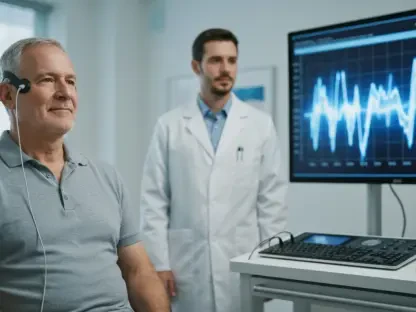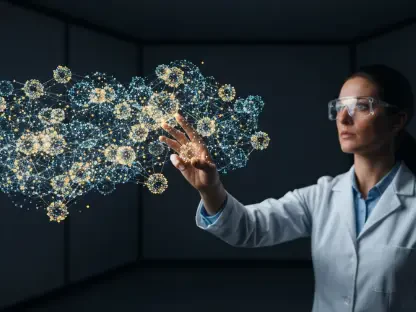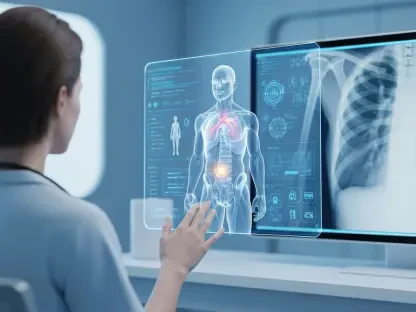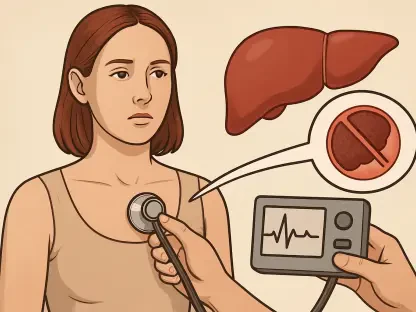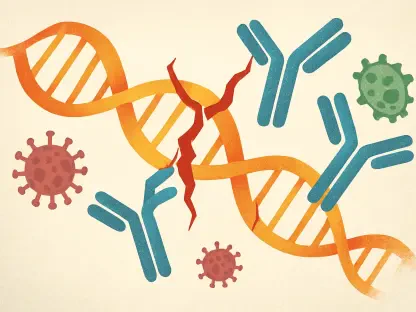Introduction
Imagine a world where common infections, once easily treatable, become deadly due to bacteria that no longer respond to existing drugs, a scenario that is becoming all too real as antimicrobial resistance claims nearly 5 million lives each year globally, creating an urgent need for innovative solutions. The rise of drug-resistant pathogens like Neisseria gonorrhoeae and multi-drug-resistant Staphylococcus aureus (MRSA) has pushed scientists to explore uncharted territories in drug discovery. This FAQ article delves into a groundbreaking approach using artificial intelligence (AI) to design novel antibiotics, addressing some of the most pressing questions surrounding this technology. Readers can expect to gain insights into how AI is revolutionizing the fight against resistant bacteria, the methods behind these discoveries, and the implications for future treatments.
The objective here is to provide clear, concise answers to key queries about AI-driven antibiotic development. By focusing on specific pathogens and cutting-edge research, the content aims to inform and guide those curious about how technology intersects with public health challenges. From understanding the mechanisms of newly designed compounds to exploring the potential of this approach, this discussion offers a comprehensive look at a transformative scientific advancement.
Key Questions
How Does AI Contribute to Antibiotic Discovery?
The integration of AI into antibiotic discovery marks a significant shift from traditional methods, addressing the critical shortage of new drugs amidst rising bacterial resistance. Unlike conventional approaches that rely on modifying existing antibiotics or screening natural compounds, AI explores vast, previously inaccessible chemical spaces to hypothesize entirely new molecules. This capability is vital as bacterial resistance evolves rapidly, rendering many current treatments ineffective against pathogens like MRSA.
Generative AI algorithms can create millions of hypothetical chemical compounds, far beyond the scope of human-designed libraries. By computationally screening these for antimicrobial properties, researchers identify promising candidates with unique structures and mechanisms. For instance, over 36 million compounds were generated in recent studies, leading to the discovery of antibiotics that target bacteria in novel ways, reducing the likelihood of pre-existing resistance.
Supporting this innovation, machine-learning models are trained to predict antibacterial activity, filtering out toxic or unstable molecules. This data-driven approach accelerates the identification of viable drugs, offering hope where traditional pipelines have stagnated. The success of such methods underscores AI’s potential to transform drug discovery into a faster, more efficient process.
What Specific Pathogens Are Targeted by AI-Designed Antibiotics?
AI-driven research has honed in on two particularly challenging pathogens known for their resistance to conventional treatments. The first, Neisseria gonorrhoeae, causes gonorrhea and has developed resistance to most available drugs, posing a serious public health threat. The second, multi-drug-resistant Staphylococcus aureus (MRSA), is notorious for causing severe skin and systemic infections, often in hospital settings, where treatment options are limited.
For N. gonorrhoeae, AI models generated compounds starting from a specific chemical fragment with known antimicrobial activity, resulting in a candidate named NG1. Lab tests and animal models demonstrated NG1’s efficacy by targeting a novel protein, LptA, crucial for bacterial membrane synthesis. This unique mechanism disrupts the pathogen’s survival in ways not seen with existing antibiotics.
Against MRSA, an unconstrained AI design approach produced over 29 million compounds, leading to a standout candidate called DN1. This compound cleared infections in preclinical models by broadly interfering with bacterial cell membranes, a strategy distinct from targeting a single protein. These targeted efforts highlight AI’s precision in addressing specific resistance challenges posed by different bacteria.
What Methods Are Used in AI-Driven Antibiotic Design?
Two distinct methodologies underpin the use of AI in creating new antibiotics, each tailored to maximize innovation against resistant bacteria. The first, a fragment-based strategy, begins with a library of chemical fragments screened for antimicrobial potential. Using tools like Chemically Reasonable Mutations (CReM), researchers build upon promising fragments to generate millions of new compounds, ensuring a structured yet creative design process.
The second method, known as unconstrained design, allows AI to freely hypothesize molecules without predefined starting points, guided only by basic chemical rules. This approach, also utilizing tools like Fragment-based Variational Autoencoder (F-VAE), fosters the creation of entirely novel structures. Both methods incorporate rigorous filters to eliminate toxic or unstable compounds, narrowing down candidates for synthesis and testing.
While millions of hypothetical molecules are designed, only a small fraction can be synthesized due to practical constraints. Yet, the success of compounds like NG1 and DN1 in lab and animal trials validates these dual strategies. This combination of targeted and exploratory design showcases AI’s versatility in tackling diverse bacterial targets with precision and creativity.
What Are the Challenges in Translating AI Designs to Real-World Treatments?
Despite the promise of AI in antibiotic discovery, significant hurdles remain in moving from computational models to clinical applications. One major challenge is the gap between theoretical design and practical synthesis. Of the millions of compounds generated by AI, only a tiny percentage can be physically produced and tested due to limitations in chemical manufacturing and resource availability.
Additionally, ensuring the safety and efficacy of these novel compounds in humans requires extensive preclinical and clinical testing. While AI can predict antibacterial activity and filter out cytotoxic molecules, real-world biological interactions may reveal unforeseen issues. The complexity of scaling up production for widespread use further complicates the transition from lab to market.
Collaboration with organizations like nonprofit entities focused on antibiotic development is crucial to overcoming these obstacles. Such partnerships facilitate medicinal chemistry refinements and preclinical evaluations, bridging the gap between innovation and application. Addressing these challenges is essential to realizing the full potential of AI-designed antibiotics in combating resistant infections.
What Are the Implications of AI-Designed Antibiotics for Future Research?
The breakthroughs in AI-driven antibiotic design carry far-reaching implications for the broader landscape of medical research. By demonstrating the ability to create structurally unique compounds with novel mechanisms, this approach opens doors to targeting other critical pathogens beyond N. gonorrhoeae and MRSA. Plans to expand research to bacteria like Mycobacterium tuberculosis and Pseudomonas aeruginosa signal a wider application of these methods.
Moreover, the methodologies developed for antibiotics could inspire advancements in other therapeutic areas, such as antiviral or anticancer drug discovery. The ability of AI to explore vast chemical spaces and predict biological activity sets a precedent for accelerating innovation across biomedical fields. This shift toward data-driven solutions aligns with growing trends in integrating machine learning into healthcare research.
Support from funding bodies like governmental defense and health agencies further ensures the sustainability of such projects. As these efforts progress from 2025 onward, the focus on novel mechanisms to outpace resistance offers a blueprint for future drug development. The ripple effects of this research could redefine how complex health challenges are addressed through technology.
Summary
This discussion encapsulates the transformative role of AI in designing novel antibiotics to combat drug-resistant bacteria. Key points include AI’s capacity to generate millions of unique compounds, targeting pathogens like Neisseria gonorrhoeae and MRSA with innovative mechanisms, as exemplified by candidates NG1 and DN1. The dual methods of fragment-based and unconstrained design highlight the adaptability of AI tools, while challenges in synthesis and real-world application remain critical considerations. The implications extend beyond current targets, promising applications for other pathogens and therapeutic areas.
These insights emphasize the urgency of addressing antimicrobial resistance through cutting-edge technology. The success in preclinical models serves as a proof of concept, reinforcing the potential for AI to revolutionize drug discovery. For those seeking deeper exploration, resources from academic journals or updates from antibiotic research initiatives provide valuable information on ongoing developments in this field.
Final Thoughts
Reflecting on the strides made, the journey of AI in antibiotic discovery reveals a powerful synergy between technology and medicine, tackling a crisis that once seemed insurmountable. The identification of novel compounds through generative algorithms marks a turning point, offering tangible hope against resistant bacteria. Each step, from computational design to preclinical success, lays a foundation for what is possible in combating infections that defy conventional treatments.
Looking ahead, the path forward involves scaling up collaborations to refine and test these promising candidates for human use. Stakeholders across research, industry, and policy spheres need to prioritize investment in AI-driven solutions, ensuring that innovations reach those in need. Exploring how this technology can adapt to individual health challenges or local resistance patterns becomes a crucial next step, urging a collective effort to safeguard global health against evolving threats.


